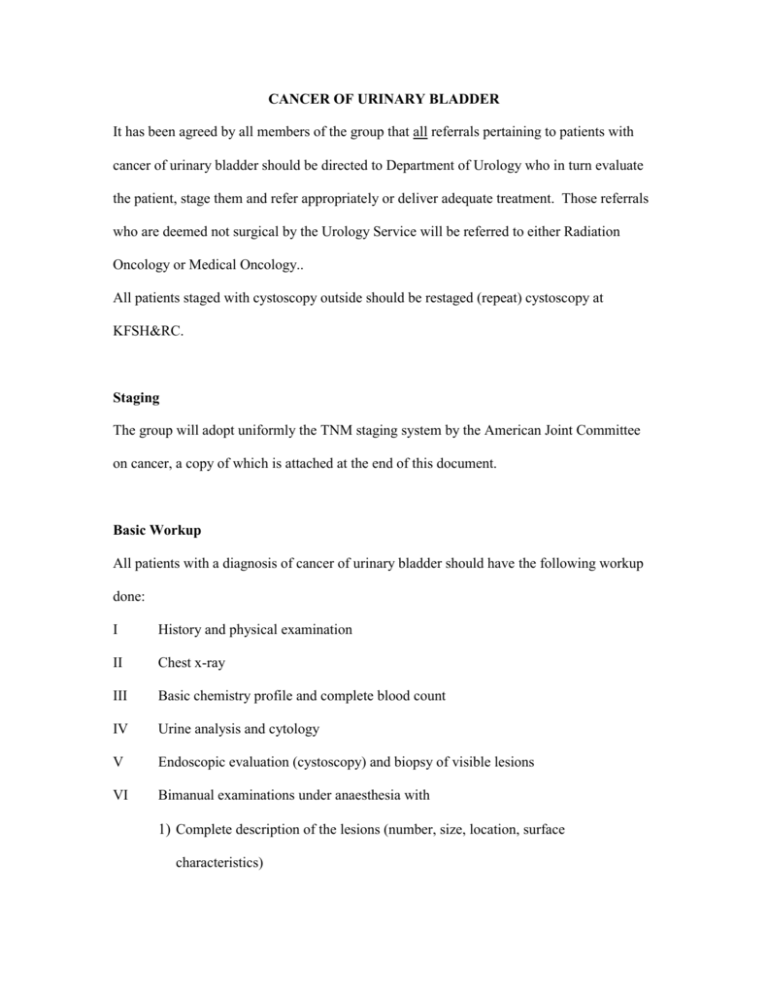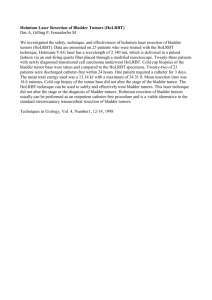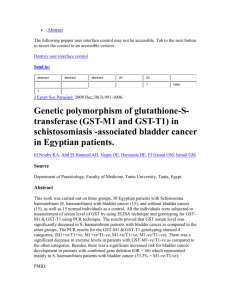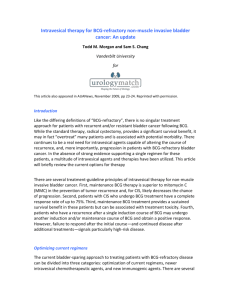CANCER OF URINARY BLADDER
advertisement

CANCER OF URINARY BLADDER It has been agreed by all members of the group that all referrals pertaining to patients with cancer of urinary bladder should be directed to Department of Urology who in turn evaluate the patient, stage them and refer appropriately or deliver adequate treatment. Those referrals who are deemed not surgical by the Urology Service will be referred to either Radiation Oncology or Medical Oncology.. All patients staged with cystoscopy outside should be restaged (repeat) cystoscopy at KFSH&RC. Staging The group will adopt uniformly the TNM staging system by the American Joint Committee on cancer, a copy of which is attached at the end of this document. Basic Workup All patients with a diagnosis of cancer of urinary bladder should have the following workup done: I History and physical examination II Chest x-ray III Basic chemistry profile and complete blood count IV Urine analysis and cytology V Endoscopic evaluation (cystoscopy) and biopsy of visible lesions VI Bimanual examinations under anaesthesia with 1) Complete description of the lesions (number, size, location, surface characteristics) 2) Bimanual examinations pre and post transurethral resection 3) Transurethral resection of lesions to include muscle layer 4) Description of bladder mucosa remote from the lesion with random biopsies 5) Measurement of bladder capacity 6) Biopsy of prostatic urethra if CIS, multicentric bladder tumor or disease at bladder neck 7) Examination of prostate and biopsy of any abnormality VII CT Scan of abdomen and pelvis for all Grade III tumors and muscle infiltrating tumors to be done no more than one month prior to patient’s evaluation. VIII Bone scan (for patients with > T2 primary tumors) Optional Studies: Renal scan- if clinically indicated Excretory urography Treatment Approaches: I. Superficial bladder cancers: These include lesions of the tumor stages: Tis, Ta, T1, No Mo. Treatment will consist of Transurethral resection (TUR). At the time of TUR, random biopsies and urinary cytology should be performed to rule out CIS. Patients will be followed up on a 3 monthly basis with repeat cystoscopies and repeat TUR of any recurrent tumors, for the first two year - if no recurrence then every 6 months for 2 more year, then yearly. Indication of Intravesical Immunotherapy/Chemotherapy 1 Carcinoma-in-situ 2 Multiple bladder tumors (regardless of the above T-stage or grade) which cannot be resected completely by TUR (too numerous, too large, cannot be reached by resectoscope). 3 Primary T1 or G3 tumors. 4 Three or more recurrences of tumors with TaG1, TaG2 stages. Methods and Dosage: BCG of a dose of 81 mg in 50cc N/S will be given as 1st line drug by weekly installations for 2 hrs intravesically for 6 weeks as tolerated. Despite maintenance therapy showed improved recurrence free survival in one trial (SWOG), four other randomized trials showed no benefit for BCG Maintenance. Patients who do not respond to the first course of intravesical BCG will be given a second course and re-evaluated. If recurrence despite repeat BCG therapy, patients will be given intravesical reduced dose BCG (27 mg in 50 cc Normal saline) concomitant with interferon alfa 10 million units weekly for 6 weeks followed by 3 weeks boast at 3 months if no recurrence as 2nd line ( level of evidence III). Alternatively Mitomycin C could be given intravesically weekly for 6 weeks. Patients with stage T1G3 who do not respond to induction BCG course will be referred to Urology for consideration of Radical cystectomy. Mitomycin C is given as 40mg in 60cc normal saline, intravesical installation for 1-2 hours weekly for 6 weeks. Indications for cystectomy in patients with superficial bladder cancer. 1 Development of G3 tumors in patients with previously G1, or G2 tumors who are not responding to intravesical therapy. 2 Uncontrolled superficial tumors (failing intravesical treatment) not amenable to transurethral resection (regardless of T stage and grade). 3 Involvement of deep prostatic ducts or stroma. 4 Persistence of transitional cell carcinoma in prostatic urethra/ducts after initial course of intravesical BCG. 5 Carcinoma in situ not responding to two coursed of induction intravesical BCG. 6. T1G3 lesions failing one line of intravesical therapy (BCG) II Muscle Invasive Bladder Cancer This includes all patients with Tumor stage T2, T3a, T3b, T4 and T4b tumors as well as patients with any T stage and N+ disease. The treatment for patients with muscle invasive bladder cancer will depend on the TNM stage as follows: T2- 4a and N0 (by CT scan): will be offered radical cystectomy. Adjuvant chemotherapy is controversial. However patients with pT3-4, N+ will be considered for Adjuvant chemotherapy with 4 cycles of Cisplatin and Gemcitabine. Patients who are not surgical candidates or who refuse surgery will be offered concomitant chemoradiotherapy with radical dose of radiation therapy if they have PS of 0-2. Chemotherapy will consist of cisplatin at 100 mg/m2 on D1,22 of radiation. Follow up after radiation therapy: cystoscopy Q3mo x 1 yr, then 6 months x 2 year then annually with urine cytology. T4b will be offered 3 cycles of neoadjuvant chemotherapy ( Cisplatin and Gemcitabine) followed by radical cystectomy. If still unresectable, patients will be offered palliative course of radiation therapy. Tany (except T4b), N+ (by CT Scan): - will undergo cytological proof of their N+ disease by FNA cytological examination - if positive, they will be offered 3-4 cycles of chemotherapy (Cisplatin and Gemcitabine). This will be followed by radical radiation treatment or radical cystectomy if complete resolution of the lymph nodes by CT scan.. Patients who are not eligible for chemotherapy (see below) will undergo palliative course of radiation treatment depending on their general condition. metastatic disease (M1) will be offered palliative chemotherapy with Gemcitabine and cisplatin. A maximum of 6 cycles will be given depending on response. The regemin cosist of: Cisplatin 75mg/m2 IV day 2 Gemcitabine 1000 mg/m2 IV over 30 minutes on days 1, 8, and 15 Cycle repeated every 28 days 20% dose reduction will be done for patients more than 70 years of age. Patients with elevated serum creatinine / decreased renal function, may be offered palliative chemotherapy with Carboplatin AUC 4.5-5 on Day 1 and Gemcitabine 1000 mg/m2 D1 and 8. Cycles every 21 days. Patient who respond to 1st line Gemcitabine / Cisplatin and relapse or progress on 1st line chemotherapy will be offered second line single agent Paclitaxel at a dose of 175 mg/m2 Guide for Radiotherapy: Radical Radiotherapy: The following information and investigations are required in planning radiation treatment for bladder cancer. a. Information from the referring urologist. Cystoscopy findings including bladder capacity inspection and documentation of papillary or solid lesions, their location and size. b. Tumor Biopsy including muscle. c. Random biopsy from elsewhere and the bladder. d. By manual examination before and after T1. Other Information: 1. History and physics examination. 2. IVP, bone scan, chest x-ray, blood chem, urinalysis & CT scan pelvis. Radiotherapy Technique: The treatment plan will include radiotherapy to the pelvis to a dose of 4000 cGy at a dose rate of 200 cGy per fraction, 5 days a week. Following this phase the bladder tumor itself will be treated to an additional dose of 2000cGy in 10 fractions at a dose rate of 200cGy per fraction five days a week for a total minimal dose to the bladder of 6000 cGy specified at the isocenter. In patients with poor performance status, bladder only can be treated with four fields as threefield technique to deliver a maximum dose of 600/d0 fractions (range 6000-6600/30-33f) or 5000-5250/20f. In a younger and fit patient, the tumor boost dose to the bladder or to the bladder tumor itself can range from 2000 to 2600 cGy at 200 cGy per fraction. The plan will achieve no more than + 5% variation in dose across the target volume. Patient will be treated with empty bladder (patient to void 15 minutes before treatment). Radiotherapy may commence less than 4 weeks after TUR if biopsy only or resection of an area less than 2 cm was performed. It is recommended that of 4 + week intervals should elapse before commencing radiotherapy after TUR of an area greater than 2 cm was done. If treatment is delayed for any reason, it is advisable that bimanual examination should be repeated. Radiation Plan: 1. Planning will be on Simulator with contrast media (15 cc of air and 30 cc of contrast) in the bladder after voiding 15 mins, pre-simulation. 2. Mega voltage equipment 6MeV and above should be used and a four-field box technique (anterior posterior in two lateral) to be used throughout both phases of therapy. If the disease is extensive, then for the first phase of the treatment i.e. pelvic fields, parallel pan technique may be used in these patients. Pelvic Fields: The entire bladder in true pelvis are to be covered. Field margins (50% isodose lines are as follows): Inferior : Caudal margin of the obturator foramen (inferior bone pelvis if prostate is involved). Superior: L5S1 or sacral promontery level. Lateral : 1.5 cm laternal to bony pelvis (at the widest point of the pelvic brim of the bony pelvis). Anterior: 1.5 cm anterior to the bladder and/or tumor (whichever is more anterior). Posterior: 2 cm posterior to the bladder and/or tumor (whichever is more posterior). NOTE: Appropriate lead blocks are allowed. However, care must be taken not to compromise the above outline target volume. Small Volume (Boost): Based on the information from EUA, cystoscopy, CT of pelvis. Field Margins: (50% isodose) will be placed using four-field technique) to cover known disease with an adequate (2cm) margin. The entire bladder need not to be necessarily included if attending radiotherapist is convinced the entire tumor is limited to one area of the bladder and will be covered within the above guidelines. Every attempt should be made to limit the field for the boost. However, it should not compromise the target of volume. Dose Fractionation: Pelvis: 4000cGy/20f/4 weeks continous course with 200cGy fractions 5 days/wk. Dose will be prescribed at isocentre. Acceptable energies include 6MV photons and higher. Small Fields Boost: - 2000 cGy/10f/2 weeks (range 2000-2600 cGy in 10 to 13f continuous course with 200 cGy fractions 5 days/wk. U. Bladder Cancer Cystoscopy,bimanual exam, random bx,CT scan Ta ,T1, Tis N0M0 T2-T4a T4b Any T Any N M1 TUR Rad cystectomy CMV X3 Carbo-CMV More than 3 rec.of TaG1-2 If Any G3 progressed Multiple N+ N- resectable unresectable Pall. care Large Any Tis Adj. CMV X 4 observation Rad. Cystectomy XRT Intravesical BCG observation palliative Survillance











